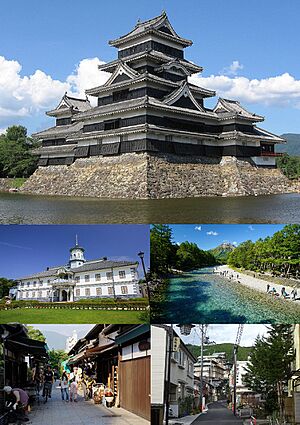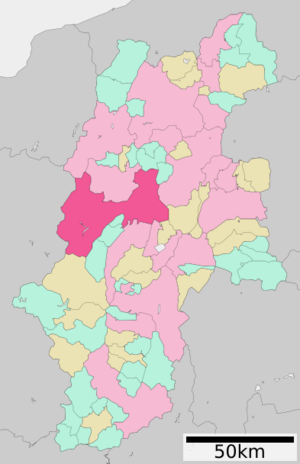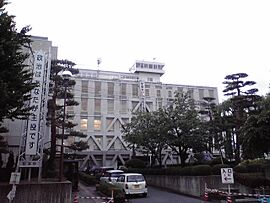Matsumoto, Nagano facts for kids
Quick facts for kids
Matsumoto
松本市
|
|||||||||||
|---|---|---|---|---|---|---|---|---|---|---|---|

From top (left to right): Matsumoto Castle, A heritage building of Kaichi School, A view of Kamikōchi, Mount Yake and Azusa creek, Nawate souvenir shopping street, A street view of Asama Spa.
|
|||||||||||
|
|||||||||||
 |
|||||||||||
| Country | Japan | ||||||||||
| Region | Chūbu (Kōshin'etsu) | ||||||||||
| Prefecture | Nagano Prefecture | ||||||||||
| First official recorded | 4th century | ||||||||||
| City settled | May 1, 1907 | ||||||||||
| Area | |||||||||||
| • Total | 978.47 km2 (377.79 sq mi) | ||||||||||
| Population
(March 1, 2019)
|
|||||||||||
| • Total | 239,466 | ||||||||||
| • Density | 244.7351/km2 (633.861/sq mi) | ||||||||||
| Time zone | UTC+9 (Japan Standard Time) | ||||||||||
| Phone number | 0263-34-3000 | ||||||||||
| Address | 3–7 Marunouchi, Matsumoto-shi, Nagano-ken 390-8620 | ||||||||||
| Climate | Cfa/Dfa | ||||||||||
|
|||||||||||
Matsumoto (松本市, Matsumoto-shi) is a city located in Nagano Prefecture, Japan. Matsumoto is designated as a core city since 1 April 2021. As of 1 March 2019[update], the city had a population of 239,466 in 105,207 households and a population density of 240 persons per km2. The total area of the city is 978.47 square kilometres (377.79 sq mi).
Contents
History
Matsumoto is located in the former Shinano Province and was the provincial capital from the Heian period onwards. The area developed as the castle town of Matsumoto Domain under the Tokugawa shogunate of the Edo period. Modern Matsumoto Town was established with the creation of the municipalities system on April 1, 1889. It was raised to city status on May 1, 1907.
On February 1, 1925, Matsumoto absorbed the village of Matsumoto (from Higashichikuma District).
The city expanded further by annexing the Kanda hamlet of the village of Nakayama from Higashichikuma District on April 1, 1943, the villages of Nakayama, Shimadachi and Shimauchi (all from Higashichikuma District) on April 1, 1954, the villages of Wada, Niimura, Kanbayashi, Sasaga, Yoshikawa, Kotobuki, Okada, Iriyamabe, Satoyamabe and Imai (all from Higashichikuma District) on August 1, 1954. Kitauchida and Gakenoyu hamlets were annexed from the Minamiuchida ward of the village of Kataoka in the city of Shiojiri on April 1, 1960 and April 1, 1961. The village of Hongo (from Higashichikuma District) on May 1, 1974 and parts of Seba hamlet (the hamlet of Kukohigashi) were annexed from Shiojiri on April 1, 1982.
Between the days of June 27 and June 28, 1994, the Matsumoto Incident sarin gas attack occurred.
Matsumoto was proclaimed a special city with increased local autonomy on November 1, 2000. Matsumoto annexed the villages of Azumi, Azusagawa and Nagawa (all from Minamiazumi District), and the village of Shiga (from Higashichikuma District) on April 1, 2005. This was followed by the town of Hata (from Higashichikuma District,) on March 31, 2010. Matsumoto was proclaimed a core city with increased local autonomy on April 1, 2021.
Geography
Matsumoto is located in the Matsumoto Basin of central Nagano Prefecture surrounded by mountains and is acclaimed for its beautiful views. It is approximately 75 kilometers south of the prefectural capital at Nagano City, and 167 kilometers from central Tokyo. The 3000 meter Hida Mountains are to the west of the city, with 3190 meter Mount Hotakadake on the border of Matsumoto with Takayama, Gifu as the highest point within the city limits.
Surrounding municipalities
- Nagano Prefecture
- Okaya
- Shiojiri
- Azumino
- Yamagata
- Asahi
- Ōmachi
- Chikuhoku
- Ueda
- Nagawa
- Aoki
- Shimosuwa
- Kiso-mura
- Kiso-machi
- Gifu Prefecture
- Takayama
Climate
Matsumoto has a humid continental climate (Köppen climate classification: Dfa) bordering on a humid subtropical climate (Köppen climate classification: Cfa), with hot summers and cold winters. Precipitation is quite high in summer, but the weather is somewhat drier in winter. The average annual temperature in Matsumoto is 12.2 °C (54.0 °F). The average annual rainfall is 1,045.1 mm (41.15 in) with September as the wettest month. The temperatures are highest on average in August, at around 25.1 °C (77.2 °F), and lowest in January, at around −0.3 °C (31.5 °F).
| Climate data for Matsumoto (1991–2020 normals, extremes 1898–present, elevation 610m) | |||||||||||||
|---|---|---|---|---|---|---|---|---|---|---|---|---|---|
| Month | Jan | Feb | Mar | Apr | May | Jun | Jul | Aug | Sep | Oct | Nov | Dec | Year |
| Record high °C (°F) | 18.8 (65.8) |
21.1 (70.0) |
25.9 (78.6) |
30.9 (87.6) |
33.6 (92.5) |
35.9 (96.6) |
37.9 (100.2) |
38.5 (101.3) |
36.1 (97.0) |
31.8 (89.2) |
25.6 (78.1) |
21.5 (70.7) |
38.5 (101.3) |
| Mean daily maximum °C (°F) | 5.1 (41.2) |
6.6 (43.9) |
11.2 (52.2) |
17.9 (64.2) |
23.6 (74.5) |
26.4 (79.5) |
30.0 (86.0) |
31.4 (88.5) |
26.2 (79.2) |
19.8 (67.6) |
13.9 (57.0) |
8.0 (46.4) |
18.4 (65.1) |
| Daily mean °C (°F) | −0.3 (31.5) |
0.6 (33.1) |
4.6 (40.3) |
10.8 (51.4) |
16.5 (61.7) |
20.2 (68.4) |
24.2 (75.6) |
25.1 (77.2) |
20.4 (68.7) |
13.9 (57.0) |
7.8 (46.0) |
2.5 (36.5) |
12.2 (54.0) |
| Mean daily minimum °C (°F) | −4.9 (23.2) |
−4.5 (23.9) |
−1.0 (30.2) |
4.4 (39.9) |
10.4 (50.7) |
15.4 (59.7) |
19.8 (67.6) |
20.5 (68.9) |
16.2 (61.2) |
9.2 (48.6) |
2.6 (36.7) |
−2.2 (28.0) |
7.2 (45.0) |
| Record low °C (°F) | −24.8 (−12.6) |
−20.4 (−4.7) |
−17.9 (−0.2) |
−10.1 (13.8) |
−2.7 (27.1) |
2.3 (36.1) |
10.2 (50.4) |
8.0 (46.4) |
3.0 (37.4) |
−3.6 (25.5) |
−8.4 (16.9) |
−19.2 (−2.6) |
−24.8 (−12.6) |
| Average precipitation mm (inches) | 39.8 (1.57) |
38.5 (1.52) |
78.0 (3.07) |
81.1 (3.19) |
94.5 (3.72) |
114.9 (4.52) |
131.3 (5.17) |
101.6 (4.00) |
148.0 (5.83) |
128.3 (5.05) |
56.3 (2.22) |
32.7 (1.29) |
1,045.1 (41.15) |
| Average snowfall cm (inches) | 33 (13) |
22 (8.7) |
12 (4.7) |
1 (0.4) |
0 (0) |
0 (0) |
0 (0) |
0 (0) |
0 (0) |
0 (0) |
0 (0) |
8 (3.1) |
76 (30) |
| Average precipitation days (≥ 0.5 mm) | 6.0 | 6.1 | 9.0 | 9.1 | 9.1 | 11.3 | 13.0 | 10.3 | 10.6 | 9.2 | 6.5 | 6.6 | 106.9 |
| Average snowy days | 16.2 | 13.3 | 11.1 | 0 | 0 | 0.0 | 0.0 | 0.0 | 0.0 | 0.1 | 2.6 | 12.0 | 55.3 |
| Average relative humidity (%) | 67 | 64 | 62 | 58 | 60 | 69 | 71 | 70 | 74 | 75 | 71 | 69 | 68 |
| Mean monthly sunshine hours | 172.5 | 171.2 | 190.9 | 204.8 | 215.6 | 166.3 | 174.8 | 202.9 | 151.0 | 160.9 | 163.0 | 160.9 | 2,134.7 |
| Source: Japan Meteorological Agency | |||||||||||||
| Climate data for Nagawa, Matsumoto (1991–2020 normals, extremes 1978–present) | |||||||||||||
|---|---|---|---|---|---|---|---|---|---|---|---|---|---|
| Month | Jan | Feb | Mar | Apr | May | Jun | Jul | Aug | Sep | Oct | Nov | Dec | Year |
| Record high °C (°F) | 12.4 (54.3) |
16.5 (61.7) |
21.4 (70.5) |
27.5 (81.5) |
30.1 (86.2) |
31.5 (88.7) |
33.1 (91.6) |
34.4 (93.9) |
32.3 (90.1) |
27.5 (81.5) |
21.8 (71.2) |
17.3 (63.1) |
34.4 (93.9) |
| Mean daily maximum °C (°F) | 1.6 (34.9) |
2.9 (37.2) |
7.2 (45.0) |
14.2 (57.6) |
19.9 (67.8) |
22.8 (73.0) |
26.3 (79.3) |
27.5 (81.5) |
22.9 (73.2) |
17.1 (62.8) |
11.2 (52.2) |
4.7 (40.5) |
14.9 (58.8) |
| Daily mean °C (°F) | −3.5 (25.7) |
−2.9 (26.8) |
1.0 (33.8) |
7.0 (44.6) |
12.5 (54.5) |
16.3 (61.3) |
20.1 (68.2) |
20.7 (69.3) |
16.5 (61.7) |
10.2 (50.4) |
4.6 (40.3) |
−0.6 (30.9) |
8.5 (47.3) |
| Mean daily minimum °C (°F) | −8.9 (16.0) |
−9.0 (15.8) |
−4.9 (23.2) |
0.2 (32.4) |
5.4 (41.7) |
10.8 (51.4) |
15.3 (59.5) |
15.8 (60.4) |
11.8 (53.2) |
4.9 (40.8) |
−0.9 (30.4) |
−5.6 (21.9) |
2.9 (37.2) |
| Record low °C (°F) | −20.4 (−4.7) |
−20.9 (−5.6) |
−17.4 (0.7) |
−13.0 (8.6) |
−4.5 (23.9) |
0.3 (32.5) |
6.6 (43.9) |
6.2 (43.2) |
−1.3 (29.7) |
−5.7 (21.7) |
−11.6 (11.1) |
−17.8 (0.0) |
−20.9 (−5.6) |
| Average precipitation mm (inches) | 81.4 (3.20) |
92.7 (3.65) |
149.9 (5.90) |
151.6 (5.97) |
180.2 (7.09) |
221.3 (8.71) |
272.0 (10.71) |
162.5 (6.40) |
242.6 (9.55) |
188.0 (7.40) |
119.7 (4.71) |
84.9 (3.34) |
1,946.8 (76.65) |
| Average precipitation days (≥ 1.0 mm) | 11.6 | 10.6 | 12.6 | 12.0 | 12.2 | 14.2 | 16.3 | 12.2 | 12.6 | 11.1 | 10.0 | 12.2 | 147.6 |
| Mean monthly sunshine hours | 108.7 | 127.1 | 157.4 | 174.9 | 195.6 | 148.4 | 152.0 | 176.8 | 140.6 | 147.9 | 125.7 | 105.1 | 1,759.5 |
| Source: Japan Meteorological Agency | |||||||||||||
| Climate data for Matsumoto Airport, Matsumoto (2003–2020 normals, extremes 2003–present) | |||||||||||||
|---|---|---|---|---|---|---|---|---|---|---|---|---|---|
| Month | Jan | Feb | Mar | Apr | May | Jun | Jul | Aug | Sep | Oct | Nov | Dec | Year |
| Record high °C (°F) | 15.5 (59.9) |
19.2 (66.6) |
24.5 (76.1) |
29.0 (84.2) |
32.2 (90.0) |
33.7 (92.7) |
35.2 (95.4) |
36.6 (97.9) |
35.2 (95.4) |
28.9 (84.0) |
23.1 (73.6) |
20.0 (68.0) |
36.6 (97.9) |
| Mean daily maximum °C (°F) | 4.0 (39.2) |
5.9 (42.6) |
10.5 (50.9) |
16.9 (62.4) |
22.6 (72.7) |
25.7 (78.3) |
28.7 (83.7) |
30.5 (86.9) |
25.6 (78.1) |
19.0 (66.2) |
13.1 (55.6) |
7.2 (45.0) |
17.5 (63.5) |
| Daily mean °C (°F) | −1.4 (29.5) |
0.0 (32.0) |
3.9 (39.0) |
9.8 (49.6) |
15.7 (60.3) |
19.6 (67.3) |
23.2 (73.8) |
24.3 (75.7) |
19.9 (67.8) |
13.4 (56.1) |
7.1 (44.8) |
1.7 (35.1) |
11.4 (52.6) |
| Mean daily minimum °C (°F) | −7.3 (18.9) |
−6.1 (21.0) |
−2.5 (27.5) |
2.7 (36.9) |
8.8 (47.8) |
14.2 (57.6) |
18.9 (66.0) |
19.6 (67.3) |
15.3 (59.5) |
8.2 (46.8) |
1.3 (34.3) |
−4.0 (24.8) |
5.8 (42.4) |
| Record low °C (°F) | −17.2 (1.0) |
−17.9 (−0.2) |
−11.9 (10.6) |
−8.8 (16.2) |
−2.4 (27.7) |
3.2 (37.8) |
11.9 (53.4) |
9.8 (49.6) |
4.5 (40.1) |
−3.2 (26.2) |
−9.2 (15.4) |
−13.7 (7.3) |
−17.9 (−0.2) |
| Average precipitation mm (inches) | 34.6 (1.36) |
41.2 (1.62) |
79.8 (3.14) |
90.6 (3.57) |
103.0 (4.06) |
113.9 (4.48) |
147.4 (5.80) |
98.3 (3.87) |
143.2 (5.64) |
151.0 (5.94) |
59.7 (2.35) |
39.6 (1.56) |
1,102.2 (43.39) |
| Average precipitation days (≥ 1.0 mm) | 4.9 | 5.6 | 7.5 | 9.0 | 8.4 | 10.1 | 12.5 | 9.9 | 9.4 | 8.1 | 5.9 | 5.3 | 96.6 |
| Source: Japan Meteorological Agency | |||||||||||||
Demographics
Per Japanese census data, the population of Matsumoto has recently plateaued after a long period of growth.
| Historical population | ||
|---|---|---|
| Year | Pop. | ±% |
| 1940 | 154,182 | — |
| 1950 | 183,775 | +19.2% |
| 1960 | 190,076 | +3.4% |
| 1970 | 203,571 | +7.1% |
| 1980 | 223,496 | +9.8% |
| 1990 | 233,756 | +4.6% |
| 2000 | 243,465 | +4.2% |
| 2010 | 243,070 | −0.2% |
| 2020 | 241,145 | −0.8% |
Economy
Matsumoto is a regional commercial center and noted for traditional woodworking and silk spinning, electronics and its dairy industry. Seasonal tourism to the surrounding mountains and onsen hot spring resorts is also an important source of local income.
Education
Universities and colleges
- Shinshu University
- Matsumoto University
- Matsusho Gakuen Junior College
- Matsumoto Junior College
Primary and secondary education
Matsumoto has 29 public elementary schools operated by the city government, one operated by the national government and one private elementary school. The city also manages 19 public middle schools, with one more middle school shared between Matsumoto and neighbouring Asahi. There is one public middle school operated by the national government and one private middle school. The city has seven public high schools operated by the Nagano Prefectural Board of Education and six private high schools. The city also has a North Korean school, Nagano Korean Elementary and Junior High School (長野朝鮮初中級学校).
Kaichi School opened in 1876; farmers gave 70% of the funds to have it built. According to Philippe Mesmer of Le Monde, Kaichi "was one of the first modern schools built in Japan." After the school closed, it was converted into a museum.
Transportation
Airport
- Matsumoto Airport
Railway
 East Japan Railway Company – Shinonoi Line
East Japan Railway Company – Shinonoi Line
- Murai – Hirata – Minami-Matsumoto – Matsumoto
 East Japan Railway Company – Ōito Line
East Japan Railway Company – Ōito Line
- Matsumoto – Kita-Matsumoto – Shimauchi – Shimatakamatsu
- Alpico Kōtsū – Kamikōchi Line
- Matsumoto – Nishi-Matsumoto – Nagisa – Shinano-Arai – Ōniwa – Shimonii – Kitanii-Matsumotodaigakumae – Niimura – Samizo – Moriguchi – Shimojima – Hata – Endō – Shin-Shimashima
Highway
 Nagano Expressway
Nagano Expressway National Route 19
National Route 19 National Route 143
National Route 143 National Route 147
National Route 147 National Route 158
National Route 158 National Route 254
National Route 254 National Route 403
National Route 403
Sister city relations
Domestic
- Fujisawa, Kanagawa, from July 29, 1961
- Himeji, Hyōgo, from November 17, 1966
- Takayama, Gifu, from November 1, 1971
International
 Salt Lake City, Utah, United States, from 1958
Salt Lake City, Utah, United States, from 1958 Kathmandu, Nepal, from November 17, 1989
Kathmandu, Nepal, from November 17, 1989 Langfang, Hebei, China, friendship city from March 21, 1995
Langfang, Hebei, China, friendship city from March 21, 1995 Grindelwald, Canton of Bern, Switzerland, from April 20, 1972
Grindelwald, Canton of Bern, Switzerland, from April 20, 1972
Local attractions
Matsumoto is attractive to travelers not only because of its traditional culture but also its moderate climate and local products. Matsumoto soba is famous for its delicate taste. Local attractions include:
- Matsumoto Castle, built more than 400 years ago. It is a Japanese National Treasure
- Kaichi School Museum, Meiji period building housing the first middle school in Japan
- Asama Onsen
- Kōbōyama Kofun, Kofun period burial mound, a National Historic Site
- Hayashi Castle, Sengoku period castle ruins, a National Historic Site
- Saito Kinen Festival Matsumoto, held every August by conductor Seiji Ozawa and featuring the Saito Kinen Orchestra
- Kamikōchi mountain area
- The Kiso Valley, a valley located Southwest of Matsumoto along which the historic Nakasendo route of the Edo period went through
Outside the rail station is also a statue of a little girl with a violin, remembering the Suzuki method of teaching music, created by Shinichi Suzuki who lived in the city in his later life.
Sports
Matsumoto is represented in the J. League of football with its local club, Matsumoto Yamaga FC based at the Alwin Stadium in Kambayashi.
It was one of the host cities of the official Women's Volleyball World Championship for its 1998 and 2010 editions.
Yoshinori Ueda was born here.
Gallery
See also
 In Spanish: Matsumoto (Nagano) para niños
In Spanish: Matsumoto (Nagano) para niños
















